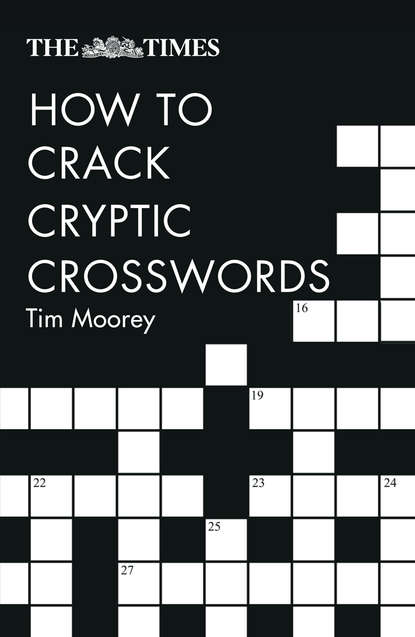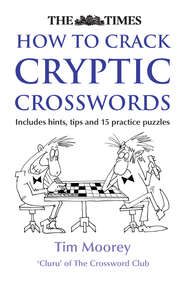По всем вопросам обращайтесь на: info@litportal.ru
(©) 2003-2024.
✖
The Times How to Crack Cryptic Crosswords
Настройки чтения
Размер шрифта
Высота строк
Поля
This next example is an anagram clue with a linkword:
ANAGRAM CLUE: Fish and chips cooked with lard (9)
The third example is one wherein the anagram fodder goes well with the definition to form a remarkably accurate whole:
ANAGRAM CLUE: The new stadium designed for a football club (4,3,6)
For is a linkword here in the sense that the wordplay is to be arranged for the answer. The essential point for indicators of anagram clues is that they show a rearrangement, a disturbance to the natural order or a change to be made. There are very many ways of doing this, some reasonably straightforward but others requiring a stretch of the imagination. For example, words and phrases related to drunkenness and madness have to be taken as involving disturbance so that stoned, pickled, tight, bananas, nuts, crackers and out to lunch could all be misleading ways to indicate an anagram. I am often asked for a comprehensive list but, because there are so many, unfortunately there is no such list, though the Chambers Crossword Dictionary (see here (#litres_trial_promo)) has a large list of anagram and other indicators. The table that follows on the next page is designed to expand on the various categories of rearrangement by giving a few examples of each overleaf:
TOP TIP - ANAGRAMS
Early crosswords did not indicate an anagram; solvers were required to guess that a mixture of letters was needed. This is universally regarded as unfair on the solver so that there will always nowadays be an indication of an anagram.
2. The sandwich clue
A sandwich can be considered as bread outside some filling. Similarly in this clue type, the solution can be built from one part either being put outside another part or put inside another part.
This is an example of outside (with an abbreviation to be made in wordplay):
SANDWICH CLUE: Simple mug holding one litre (6)
This is an example of inside with a clear instruction as to what’s to be done:
SANDWICH CLUE: Family member put us in the money (6)
Note that about has multiple uses in crosswords (see Chapter 10 (#litres_trial_promo)).
3. The homophone clue
In this type, the solution sounds like another word given by the wordplay. The clue is often fairly easy to recognize but it may be harder to find the two words which sound alike.
HOMOPHONE CLUE: The Speaker’s feeble for seven days (4)
Indicators for homophone clues:
Anything which gives an impression of sounding like another word such as so to speak, we hear, it’s said acts as an indicator. This extends to what’s heard in different real-life situations; for example, at home it could be on the radio; in the theatre it could be to an audience; in the office it could be for an auditor.
4. The hidden clue
A hidden clue is arguably the easiest type to solve. That’s because the letters to be uncovered require no change: they just need to be dug out of the sentence designed to conceal them. In the first example, the indicator is inside:
HIDDEN CLUE: Parched inside Kalahari desert (4)
Indicators for hidden clues:
Commonly some (in the sense of a certain part of what follows), some of, partly, are unique to hidden clues; within, amidst, holding and in can be either hidden or sandwich indicators.
A variant of the hidden clue is where the letters are concealed at intervals within the wordplay, most commonly odd or even letters. You are asked to extract letters that appear as, say, the first, third and fifth letters in the wordplay section of the clue sentence and ignore the intervening letters. Note that there will never be superfluous words in such a clue sentence, making it easier to be certain which letters are involved in the extraction.
Here is one such clue in which you have to take only the odd letters of the bar for the solution.
HIDDEN CLUE: Drink in the bar regularly (3)
Some other indicators for hidden-at-intervals clues:
Oddly, evenly, ignoring the odds, alternately.
5. The takeaway clue
A takeaway clue involves something being deducted from something else. This can be one or more letters or a whole word. In the example below it’s one letter, R, which is an abbreviation of right, and get is an instruction to the solver. It should be noted that sometimes you will find abbreviations signposted, e.g. “a small street”, more usually not, e.g. “street”. You will find in the Appendices a list of those most frequently appearing in crosswords and all of those used in the clues and puzzles of this book.
TAKEAWAY CLUE: Get employed right away in Surrey town (6)
In our second example, it’s the last letter that is to be taken away to leave the solution:
TAKEAWAY CLUE: Silent Disney movie unfinished (4)
Indicators for takeaway clues:
These tend to be self-explanatory, such as reduced, less, extracted, but, beware, they can be highly misleading, such as cast in a clue concerning the theatre, or shed in one ostensibly about the garden. Some indicators inform us that a single letter is to be taken away. These include short, almost, briefly, nearly and most of, all signifying by long-established convention that the final letter of a word is to be removed. There is more on takeaway indicators such as unopened, disheartened, needing no introduction and endless on here (#ulink_527460eb-77e2-5135-be74-102d605104d8), which deal with letter selection indicators.
6. The reversal clue
The whole of a solution can sometimes be reversed to form another entirely different word. In addition, writing some letters backwards or upwards is often part of a clue’s wordplay, but for the time being we are concerned with reversal providing the whole of the answer. This is a clue for an across solution:
REVERSAL CLUE: Knock back beer like a king (5)
This is a reversal clue for a down solution (see below for an explanation of why this matters):
REVERSAL CLUE (DOWN): Boat however turned up (3)
Indicators for reversal clues:
Anything showing backward movement, e.g. around, over, back, recalled.
Do be aware that some reversal indicators apply to down clues only, reflecting their position in the grid. The example above of a down clue uses turned up for this purpose; other possibilities are overturned, raised, up, on the way up and served up.
7. The letter switch clue
Where two words differ from each other by one or more letters, this can be exploited by setters so that moving one or more letters produces another word, the solution. Here is an example in which you are instructed to shift S for South along a word meaning coast to produce a fish. You are not told which of the two s’s is to be moved but trial and error will eventually show it’s the second.
An extra point to be brought out here is that if a pause or comma after the first word is imagined, the instruction should become clearer. This imaginary punctuation effect is common to many crossword clues; see Chapter 4 (#ulink_49035318-af78-5c19-9323-d4b3fcbf1069), here (#ulink_42e0a649-b807-5749-9180-76511a0fa857), for more on this point.
LETTER SWITCH CLUE: : Fish move south along the coast (3,5)
There is also a form of letter switch in which letters are replaced rather than moved; see Chapter 8 (#litres_trial_promo), here (#litres_trial_promo), for more on this.
8. The all-in-one clue






